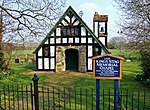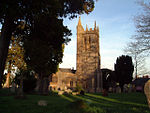Lydlinch

Lydlinch is a village and civil parish in the Blackmore Vale in north Dorset, England, about three miles (five kilometres) west of Sturminster Newton. The village is sited on Oxford clay close to the small River Lydden. The parish – which includes the village of King's Stag to the south and the hamlet of Stock Gaylard to the west – is bounded by the Lydden to the east and its tributary, the Caundle Brook, to the north. The 2011 census recorded the parish as having 199 dwellings, 192 households and a population of 437.At King's Stag is the King's Stag Memorial Chapel which was built in 1914 at the expense of the Right Rev. Huyshe Yeatman-Biggs, the Bishop of Worcester, in memory of his wife, Lady Barbara Yeatman-Biggs, who died in 1909.
Excerpt from the Wikipedia article Lydlinch (License: CC BY-SA 3.0, Authors, Images).Lydlinch
Holebrook Lane,
Geographical coordinates (GPS) Address Nearby Places Show on map
Geographical coordinates (GPS)
| Latitude | Longitude |
|---|---|
| N 50.9204 ° | E -2.3665 ° |
Address
Holebrook Lane
Holebrook Lane
DT10 2JA , Lydlinch
England, United Kingdom
Open on Google Maps









